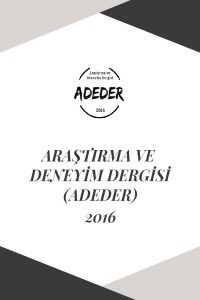PERCEPTIONS OF COVID 19 AND ONGOING PANDEMICS BY CHILDREN IN THE PRIMARY SCHOOL STUDENTS
The present study is aimed to define how the COVID-19 pandemic was perceived amongst the primary school children by the pictures they did. The study group, in which the qualitative research method was used, included 241 first grade students in a primary school in the Antalya Kepez region, which was selected by the convenient sampling method. While collecting data in the research, students were asked "what do you understand when the COVID-19 is mentioned?" and to draw a picture of their feelings. The data were evaluated as a percentage (%) and frequency with the SPSS program. In the conclusion of the study, it was observed that most of the students in the study group perceived the COVID-19 as "an insect", and less of the students perceived it as "a disease". COVID-19 pandemic is drawn by the children generally as a free time activity at home.
Anahtar Kelimeler:
Covid-19, perception, children pictures
PERCEPTIONS OF COVID 19 AND ONGOING PANDEMICS BY CHILDREN IN THE PRIMARY SCHOOL STUDENTS
The present study is aimed to define how the COVID-19 pandemic was perceived amongst the primary school children by the pictures they did. The study group, in which the qualitative research method was used, included 241 first grade students in a primary school in the Antalya Kepez region, which was selected by the convenient sampling method. While collecting data in the research, students were asked "what do you understand when the COVID-19 is mentioned?" and to draw a picture of their feelings. The data were evaluated as a percentage (%) and frequency with the SPSS program. In the conclusion of the study, it was observed that most of the students in the study group perceived the COVID-19 as "an insect", and less of the students perceived it as "a disease". COVID-19 pandemic is drawn by the children generally as a free time activity at home.
Keywords:
Covid-19, perception, children pictures Covid-19, perception, children pictures,
___
- Akgun, E. & Ergul, A. (2015). Evaluation of Family Perception in Pictures of 55-74 Month-Old Children. Cukurova University Journal of Education, (44) 2, 209-228.
- Artut, K. (2004). A review of the linear development levels of children in preschool painting education. Cukurova University Journal of Social Sciences Institute ,, 13 (1), 223-234.
- Aykac, N. (2012). Perception of teacher and learning process in primary school students' paintings. Education and Science, 37 (164), 298-315.
- Buldu, M. (2006). Young children's perceptions of scientists: a preliminary study. Educational Research, 48 (1), 121-132.
- Daglioglu, H. E. (2011). Comparative analysis of the teacher figure reflected in the pictures of children aged 5-7. Education and Science, 36 (160), 144-157.
- Dogru, Turcan, Arslan & Dogru. (2006). Evaluation of Families Identification Situations in Pictures of Children. Selcuk University Institute of Social Sciences Journal, 15, 223-235.
- Eristi, S.D. & Kurt, A.A. (2011). Elementary school students’ perceptions of technology in their pictorial representations. Turkish Online Journal of Qualitativeb Inquiry, 2 (1) 24-37.
- Ersoy, A. &Turkkan, B. (2009). Perceptions about internet in elementary school children’s drawings. Primary school Online, 8 (1), 57-73.
- Nazlı, S.R.& Çat, K.A. (2021) The Reflection of Children’s Covid-19 Perceptions to Their Drawings. Journal of Akdeniz University Faculty of Communication,36, 221-242.
- Pek, E. (2021). Reflectıons Of The Covıd-19 Pandemıc On Chıldren's Drawıngs. Journal of Art and Language, 10 (88), 1737-1746.
- Şen-Beytut, D., Boisik, B., Solak, U. & Seyfioglu, U. (2009). Examination of the effects of hospitalization in children through the projective method of drawing. Maltepe University Journal of Nursing Science and Art, 2 (3), 35-44.
- Tas, Y., Aslan, D. & Sayek, I. (2006). How do children reflect the profession of medicine in their paintings? An example made among children aged 7-12. Journal of Continuing Medical Education, 15 (11), 184- 191.
- Tiryaki Ö, Zengin H, Çınar N. (2021). Reflection of Children's Perceptions of the COVID-19 Pandemic on Their Drawings. Ordu University Journal of Nursing Studies, 4(3), 296-305.
- Turan, S. (2018). What Is Qualitative Research? (S. Turan, Çev. Edt.) , Qualitative Research A Guide to Desing and Implementation. Nobel Yayıncılık. Ankara.
- Turkmen, H. (2008). Turkish Primary Students' Perceptions about Scientist and What Factors Affecting the Image of the Scientists. Eurasia Journal of Mathematics, Science & Technology Education, 4 (1), 55- 61.
- Yayan, G. (2020). Reflections of Covid-19 as a Pandemic in the Paintings of the Students at Gazi University Gazi Education Faculty Fine Arts Department Art Painting Major.Turkish Studies, 15(4), 1297-1313.
- Yildirim, A. & Simsek, H. (2011). Qualitative research methods in the social sciences. Ankara: Seckin Publications.
- Yayın Aralığı: Yılda 2 Sayı
- Başlangıç: 2016
- Yayıncı: Ayten KİRİŞ AVAROĞULLARI
Sayıdaki Diğer Makaleler
Öğretmenlerin Şiddet ve İstenmeyen Öğrenci Davranışı Algıları: Bir Odak Grup Görüşmesi
USUL-İ TEDRİS BAĞLAMINDA OSMANLI’DA ÖĞRETMEN YETIŞTIRME VE FORMASYON TARTIŞMALARI
PERCEPTIONS OF COVID 19 AND ONGOING PANDEMICS BY CHILDREN IN THE PRIMARY SCHOOL STUDENTS
Hatice GÜRSES, Behsat SAVAS, Özgür ARSLAN
FEN EĞİTİMİ ALANINDAKİ AKADEMİSYENLERİN STEM EĞİTİMİ İNANÇLARI
